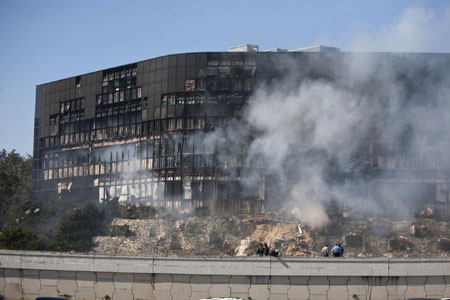Asia-Pacific
Angry man crashes plane into Texas tax building
(Agencies)
Updated: 2010-02-19 10:24
 |
Large Medium Small |
|
 A small aircraft crashed into a building next to an FBI office in the Texas state capital of Austin on February 18, 2010, local officials said. [Agencies]
|
The building, in a heavily congested section of Austin, was still smoldering six hours later, with the worst of the damage on the second and third floors.
The entire outside of the second floor was gone on the side of the building where the plane hit. Support beams were bent inward. Venetian blinds dangled from blown-out windows, and large sections of the exterior were blackened with soot. It was not immediately clear if any tax records were destroyed.
Andrew Jacobson, an IRS revenue officer who was on the second floor when the plane hit with a "big whoomp" and then a second explosion, said about six people couldn't use the stairwell because of smoke and debris. He found a metal bar to break a window so the group could crawl out onto a concrete ledge, where they were rescued by firefighters. His bloody hands were bandaged.
Austin Police Chief Art Acevedo said "heroic actions" by federal employees may explain why the death toll was so low.
The FBI was investigating. The National Transportation Safety Board sent an investigator as well.
Rep. Michael McCaul, a Republican from Austin on the Homeland Security Committee, said the panel will take up the issue of how to better protect buildings from attacks with planes.
In the long, rambling, self-described "rant" that Stack apparently posted on the Internet, he began: "If you're reading this, you're no doubt asking yourself, `Why did this have to happen?'"
He recounted his financial reverses, his difficulty finding work in Austin, and at least two clashes with the IRS, one of them after he filed no return because, he said, he had no income, the other after he failed to report his wife Sheryl's income.
He railed against politicians, the Catholic Church, the "unthinkable atrocities" committed by big business, and the government bailouts that followed. He said he slowly came to the conclusion that "violence not only is the answer, it is the only answer."
"I saw it written once that the definition of insanity is repeating the same process over and over and expecting the outcome to suddenly be different. I am finally ready to stop this insanity. Well, Mr. Big Brother IRS man, let's try something different; take my pound of flesh and sleep well," he wrote.
According to California state records, Stack had a troubled business history, twice starting software companies in California that ultimately were suspended by the state's tax board, one in 2000, the other in 2004. Also, his first wife filed for bankruptcy in 1999, listing a debt to the IRS of nearly $126,000.
The blaze at Stack's home, a red-brick house on a tree-lined street in a middle-class neighborhood six miles from the crash site, caved in the roof and blew out the windows.
Elbert Hutchins, who lives one house away, said the house caught fire about 9:15 a.m. He said a woman and her daughter drove up to the house before firefighters arrived.
"They both were very, very distraught," said Hutchins, a retiree who said he didn't know the family well. "'That's our house!' they cried. `That's our house!'"
Red Cross spokeswoman Marty McKellips said the agency was treating two people who live in the house.
Thursday was not the first time a tax protester went after an Austin IRS building. In 1995, Charles Ray Polk plotted to bomb the IRS Austin Service Center. He was released from prison in October of last year.
The tax protest movement has a long history in the US and was a strong component of anti-government sentiments that surged during the 1990s. That wave culminated in the 1995 bombing of a federal building in Oklahoma City that killed 168 people. Several domestic extremists were later convicted in the plot.






